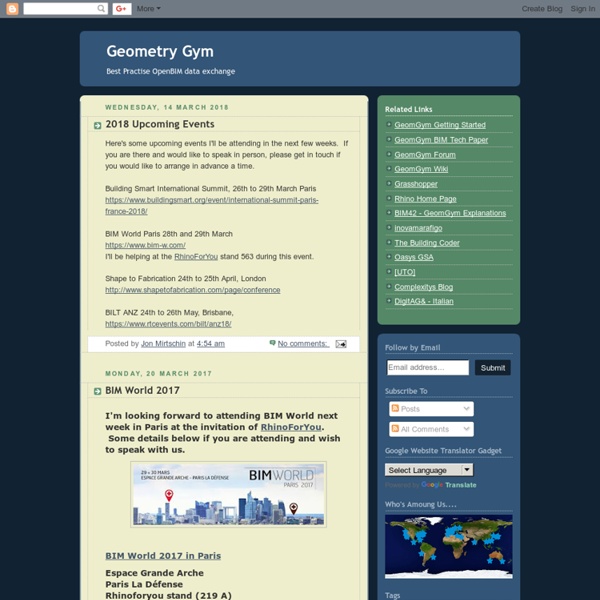Geometry Gym
There's been a few private and public discussions about Parametric IFC and IFC for Content. As a prelude refer to http://mdradvies.blogspot.nl/2013/10/ifc-for-content.html and perhaps we need a twitter hash tag? Manufacturers and suppliers are caught in a difficult situation at the moment about generating BIM data and leveraging the best value (and success) in doing so. There is obviously a cost in preparation and there is little choice at the moment but to either generate pick which BIM software that native content can be created for or generate IFC as neutral data. Budget, time and expertise constraints make it highly unlikely anyone will author native content for all BIM software (and is a lot of duplicated effort). Current BIM software capability with IFC is presently leads to a lot of frustration and poor performance, but I don't think it has to be that way and will try to convey that with this blog post.
http://geometrygym.blogspot.com/
Post-Planetary Design
Freeman Dyson talks about near term and long term human travel off planet in his Noah’s Ark Eggs and Warm-Blooded Plants lecture at the recent Starship Century conference, A. C. Clarke Center [UCSD] conference. "On June 30, 2004, the Cassini spacecraft entered orbit around Saturn to begin the first in-depth, up-close study of the ringed planet and its domain.
DesignReform
In this video, we cover the Spring Force within Kangaroo in a simple case. In this video, we give an introduction to the paneling tools within the LunchBox plugin for Grasshopper. In this video, we give an introduction of Kangaroo, a plugin for Grasshopper developed by Daniel Piker.
Weaverbird 0.5.20 NewYear
Weaverbird is a topological modeler that contains many of the known subdivision and transformation operators, readily usable by designers. Instead of doing the work repeatedly, or sometimes using complicated scripts, this plug-in reconstructs the shape, subdivides any mesh, even made by polylines, and helps preparing for fabrication. Weaverbird – 0.9.0.1 For Rhino 6 using Yak. Open this Grasshopper definition to install Weaverbird using the new-in-Rhino-6 Yak packet manager.
Galapagos and GSA solver
It's still early stages of testing and development of some recent work I've been doing to enable access to GSA solver directly within Grasshopper (and importantly Galapagas). The attached example is still primitive, I'll find a moment to extend it to include a stiffness per mass objective, but it does demonstrate a few aspects of using this technique. All feedback appreciated, including requests for more components to save manual generation of GWA attributes (which is shown for the point load generation). Grasshopper DefinitionsGSA SAP SpaceGASS Egret Robot
rhino5live
Upcoming webinars - See Rhino 5 live For more, check back soon!! More are being planned.
Volatile Prototypes / hoopsnake: Iteration in Grasshopper
Update: Hoopsnake is now Opensource! More info at Github HoopSnake, apart from a legendary creature, is a component for the Grasshopper™ 3D platform.
Mattia Gambardella
Once revised and analysed all the experiments carried out in both physical and digital realms, a final design strategy is developed. Just the most successful physical experiments and digital tools will be used for that purpose. In this case the wool threads and the catenaries experiments are the ones that are chosen in order to inform the digital tools, that are the topology optimization code in Matlab, the minimizing paths system algorithm in Generative components, and the Finite Elements Analysis software Ansys for both structural analysis and 3D topology optimization. In the local scale the experiments chosen are the foam as a form for laying out the fibers, and the lycra knot to study how to lay out fibers in complex geometries. This design methodology combines structural topology optimization in a routine in Matlab with a minimizing path system algorithm implemented in Generative Components.
object-e.net » Archive » Hybrid*
Hybrid is a design project for a new building for the School of Architecture of Washington University in St Louis. The main idea for the project was to fuse the limits between building and landscape. While many projects have dealt with that idea through buildings that emerge out of the ground, hybrid follows a different and maybe paradoxical approach. The building is elevated leaving the ground plane largely open.
Related:


